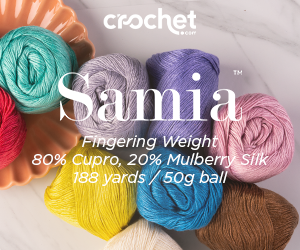Yarn Substitutions - The Struggle Is Real
/Yarn Subbing is one of the most fun and equally frustrating parts of loving fiber arts and making things. Because not all yarn is available everywhere but all patterns can be found online, it can present challenges to make something when the pattern calls for a yarn not available to you. It is a terrible reality we must face often.
So this guide will hopefully help you always be informed to get the yarn you need to make the pattern you want.
Most patterns, including mine, will reference a specific yarn and you should always try to you that yarn to achieve "that" look. But... Yes, of course it's possible to substitute one yarn for another yarn. In fact, for my patterns I list the Category or weight of yarn and then state the yarn used for the design as reference.
How to know what yarn to substitute?
In the ever changing world of yarn, sometimes knowing what yarn to get for a pattern is hard enough. Understanding yarn weights is key to achieving the perfect result for your knitting and crochet projects, whether it's a cozy winter scarf, a delicate baby blanket, or a chunky knit sweater. By understanding yarn weights you can easily sub out any yarn if a certain yarn is not available or know what to get for a pattern while you travel.
So, let's unravel the mystery of yarn weights together!
What is Yarn Weight?
The basics: Yarn weight isn't about how heavy a ball of yarn is; it refers to the thickness of the yarn strand. The yarn weight affects how bulky or fine your finished project will be, and it determines the size of knitting needles or crochet hooks you’ll need to use. It's essential to match the yarn weight to your project to ensure it comes out the right size and texture.
How to know the right yarn weight to use?
Most patterns will tell you the specific yarn used for the design process. But if you do not have access to that particular yarn, or if you are shopping in your stash, then having a deep understanding of yarn weights will help you know what yarn to use for your pattern.
What are Yarn Weight Categories.
Yarn weights range from lace weight, the thinnest, to super bulky, the thickest. Let's take a closer look at each category.
Lace (0): Lace weight yarn is the thinnest yarn available. It's delicate and often used for making doilies, lace shawls, and other intricate items. Because of its thinness, it requires small needle sizes (000 to 1 in US sizes, or less than 2.25 mm). It is often great for using as an accent with a heavier weight yarn too.
Super Fine (1): Also known as fingering or sock yarn, it's typically used for making socks, baby items, or lightweight garments. Needle sizes for this yarn weight usually range between 1 to 3 US (2.25 to 3.25 mm).
Fine (2): Often referred to as sport weight yarn, it's a little thicker than super fine yarn. It's great for lightweight garments, such as baby clothes and light sweaters. needles / hooks in the 3 to 5 US range (3.25 to 3.75 mm) are typically used with this weight.
Light (3): Known as DK (double knitting) or light worsted yarn, it's versatile and suitable for a wide range of projects like scarves, hats, and lightweight garments. Suitable needle sizes range from 5 to 7 US (3.75 to 4.5 mm).
Medium (4): Known commonly as worsted (and can sometimes include Aran weight), this is perhaps the most commonly used yarn weight. It's excellent for blankets, scarves, sweaters, mittens, and more. Ideal needle sizes for this weight are 7 to 9 US (4.5 to 5.5 mm).
Bulky (5): Bulky yarn is perfect for creating cozy scarves, hats, blankets, and sweaters that knit and crochet up quickly. It's typically used with larger needles / hooks, 9 to 11 US (5.5 to 8 mm).
Super Bulky (6): Super bulky yarn is great for heavy blankets, rugs, scarves, and other warm winter items. It's often used with very large needles / hooks, sizes 11 to 17 US (8 to 12.75 mm).
Side note this is my go to weight for quick holiday gifts and when I used to sell finished goods at markets, this was the most popular weight for scarves.
Jumbo (7): Jumbo yarn is the thickest yarn weight and is excellent for arm knitting or making big stitch items. It's typically used with the largest needles / hooks, sizes 17 US and up (12.75 mm and up).
Gauge: The Secret to Perfect Fit and Perfect Yarn Selection
Gauge is the number of stitches and rows per inch you get with a specified size of needle or hook. You can read more about gauge here. It's crucial when knitting or crocheting garments or anything that needs to fit a specific size, that you have steady gauge.
Always make a gauge swatch before starting your project to ensure your final product will be the right size. Your gauge swatch will help you determine if you have the right yarn for your project.
Choosing the Right Yarn Weight
The pattern you're working on will recommend a specific yarn weight and needle size. However, feel free to experiment once you're more comfortable with your knitting and crochet skills! Just remember that changing the yarn weight or needles / hooks size will impact the size and look of the final product.
Understanding yarn weights is the first step in expanding your fiber expertise and being prepared to sub out as needed to make things. While this guide is meant to give you an outline and a general rule of thumb, a lot will come down to the exact knit or crochet pattern you are making and remember that the exact properties of yarn can vary depending on its material and brand. Always check the yarn label for specific information about the yarn's weight and recommended needle or hook size…
And like I said earlier, always do a gauge swatch!
Happy yarn subbing :-)























